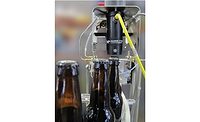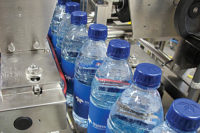Inspection equipment adapts to market needs
Non-contact inspection remains popular in beverage industry


One of Teledyne TapTone’s most popular offerings, its dual-compression sensor (DSC) system, uses two force sensors to detect leakage in non-pressurized plastic bottles. (Image courtesy of Teledyne TapTone)


The product name has been trademarked; the formulation has been perfected and patented; the packaging is unique and shelfworthy; yet, this product might never make it to retail because the owner forgot about one vital step: inspection.
“It’s important that when you’re developing a new container, you talk with a leak inspection expert ahead of time,” says Robert Chevalier, engineering manager for Teledyne TapTone, North Falmouth, Mass. He notes a specific instance in which a manufacturer built the plant, set up the line, and was ready to run production before it realized the package needed to be inspected. At that point, once Teledyne TapTone attempted to inspect the package, it determined that it was uninspectable by any technology currently in existence or that could be created, he explains. As a result, the container had to be redesigned. “There are times that containers come out that are uninspectable completely, and usually those will never make it to market,” he says.
In other cases, new and unique packaging formats can be accommodated with special inspection solutions. For instance, Teledyne TapTone has designed special sets of tapered belts for its force inspection technology that match the curvature of shapely bottles so that it can squeeze them precisely to discover any leaks, Chevalier explains.
The company’s T-4000 force sensor (FS) can detect leaks and low pressure in liquid-nitrogen-dosed containers and carbonated beverage containers. It does so by squeezing the container through a set of belts and measuring the sidewall pressure, Chevalier notes. Teledyne TapTone also offers a dual-compression sensor (DSC), which uses two force sensors to detect leakage in non-pressurized plastic bottles. This technology works by squeezing the container through a set of belts but first measures the pressure at the beginning of the compression and again at the end in order to identify any difference between the two measurements, he explains. These inspection technologies represent the company’s most popular solutions, he notes.
Additionally, these belted force technologies are particularly accurate compared with non-contact inspection sensors, Chevalier notes. “There’s a little more wear and tear with belts sometimes on the machines that actually squeeze the containers, but the cost of ownership to replace one [or two] sets of belts per year is not very high for the actual measurement that you get,” he says.
Also offering leak inspection but with minimized contact to the product, BBull USA Inc., Oldsmar, Fla., recently introduced its BBull Pulse technology for PET bottles and aluminum cans. The new system consists of a simple, compact, over-line inspection bridge that uses a probe to measure subtle variations in the internal pressure of the container, explains Mike Lawn, director of BBull USA.
Can’t touch this
Inspection systems that do not come into contact with the product at all remain popular within the beverage industry. In particular, metal detectors, X-ray machines and vision systems are the most common types of inspection equipment, and all of them are contactless, notes Bob Ries, lead product manager of metal detection and X-ray inspection for Thermo Fisher Scientific, Minneapolis.
Most commonly, high-speed production lines face problems relating to incorrect fill levels, Ries says. To address this, operators can equip their lines with X-ray machines for fill-level detection, he says. These systems also can detect common problems like missing or cocked caps or closures. However, BBull USA’s Lawn notes that when it comes to cap detection solutions, vision-based systems are trending. These systems can more accurately detect high caps and cocked caps, he says. BBull’s Compact Vision system uses a single camera to inspect for fill level as well as cap presence, height and position. Taking this to the next level, the BBull Image 120 uses two additional cameras to detect split tamper bands and inspect labels, he adds.
Similarly, Teledyne TapTone recently released its SelectVu single-camera vision system, which is a low-cost inspection option for detecting caps, tamper bands/rings, fill level and codes, Chevalier notes.
Cracking the code
“A lot of people want to make sure that the date code is printed correctly on the containers,” Chevalier says. “We can do OCR, which is optical character recognition, to be able to actually tell if the code is correct — not just if it’s present or absent — but we also can look at each character and make sure it’s the correct code for that lot.”
Inspection of date codes and labels is becoming more necessary as regulations like the Food Safety Modernization Act (FSMA) come into play, notes Stephen Dryer, product manager for Mettler Toledo CI-Vision, Aurora, Ill.
“Enhanced regulations, such as FSMA, which are shifting the focus from reactive measures to preventative ones, are making it necessary to more closely scrutinize labels and packaging to ensure that the label matches the package contents,” he says. “While always important, the past few years have seen a strong growth in the demand for inspection systems that guard against this type of defect.”
Mettler Toledo CI-Vision’s preferred beverage inspection solution is the full-bottle inspection (FBI) system, which visually inspects products for fill level, cap presence and position, and tamper band integrity, Dryer says. The system also has code-reading capabilities that enable it to verify that the correct containers and labels are on the line, he adds.
Getting contaminants into view
In addition to misapplied caps and labels, bottom-of-the-package contaminants are another common problem for beverage-makers, Thermo Fisher Scientific’s Ries adds. “Automatic inspection systems are available to detect these issues at production speeds, rejecting the bad products so production personnel can take corrective action,” he says.
In terms of bottom-of-the-package contaminants, empty bottle inspection has traditionally been used to detect contamination, BBull USA’s Lawn says. However, contamination also can occur during the filling and capping process, he notes. Thus, operators can inspect the bottles after filling and capping, but the inhomogeneous nature of the glass at the base of a bottle where dense contaminants typically rest can make it difficult to inspect. Therefore, the BBull Protecx in-feed X-ray unit inverts the bottle, allowing the particulates to rest on the closure of the container. In this more uniform and confined area, the X-ray technology can more clearly identify smaller fragments, he explains.
Recently, Eagle Product Inspection also introduced an X-ray solution for high-speed inspection of cans, jars, bottles, upright containers and composite lines, notes Kyle Thomas, strategic business unit manager for the Tampa, Fla.-based company. The new Eagle Tall Pro XSDV technology features a dual-view X-ray inspection system complete with a new reject function and is capable of detecting contaminants as much as 50 percent smaller than traditional machines, he says. The system works by using a single X-ray generator that produces two beams, enabling the inspection of different sides, and maximizes detection rates, he adds.
"Eagle’s X-ray technology provides inspection and detection of contaminants that were previously almost impossible to detect," Thomas says. "With the ability to perform full scans on the product, including areas previously considered blind spots, operators are provided with an image that clearly identifies hazardous contaminants such as glass shards within glass containers, metal fragments in metalized film packaging, mineral stone and plastic/rubber compounds. Additionally, Eagle’s technology has the added benefit of inspecting fill levels, seal integrity and mass measurement to ensure product quality and quantity for the retailer and consumer."
Multi-tasking technologies
With beverage-makers facing numerous packaging and production obstacles relating to fill level, closure, labeling, coding and more, FT System North America continues to see an increase in the popularity of its multi-technology solutions, says Rick Reardon, general manager for the Suwanee, Ga.-based company.
“These would include systems like high-frequency inspection for fill-level inspection combined with vision for cap application inspection,” he explains.
Teledyne TapTone plans to combine all of its sensor technologies into a new system later this year, Chevalier notes. The system will enable sensors on as many as four bottling lines to communicate back to one computer, he says. This can save customers money by reducing the number of displays and operators needed to get information from all of the lines at the same time, he adds.
Eagle's Thomas affirms this multi-tasking trend, saying, "Having a machine with multiple technologies reduces the number of steps needed on the production line, saving time and additional costs for multiple machineries." For example, Eagle offers innovations that provide both product and package inspection/detection. This increased efficiency increases the manufacturer’s production and profit margins, he says.
However, FT System’s Reardon adds that inspection equipment should do more than just detect defective containers. It also should provide statistical data on the process being inspected, he says.
“A good inspection solution will not only identify and remove the defect from the line, but it will alert the operator to the cause of the defect,” he explains.
Along these lines, FT System released an iPad application that enables its customers to monitor all of their inspection stations on the line from their devices, Reardon notes. If an inspection station detects a trend toward a defect, it will send out a message to the operator, he adds.
Adapting and innovating
As SKU proliferation and lightweighting remain rampant in the beverage industry, suppliers continue to be challenged to innovate, Reardon says.
“Inspection systems need to be flexible enough to accommodate a wide and ever-changing range of container types,” he says. “Lighter packaging material, new shapes and sizes, combined with the need to quickly change over from one container to another are what fueled the development of our line of non-contact leak and pressure inspection systems.”
Reardon notes that FT System’s PCS700 series of non-contact, in-line pressure/vacuum inspection systems, in particular, are very popular. The technology can be used on lines that run liquid-nitrogen-dosed and carbonated beverages as well as hot-filled and high-pressure-processed beverages.
Looking for a reprint of this article?
From high-res PDFs to custom plaques, order your copy today!








